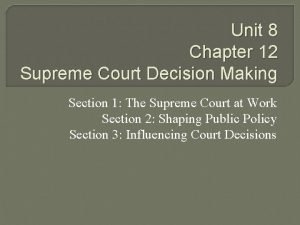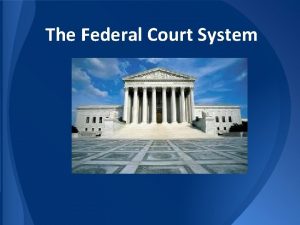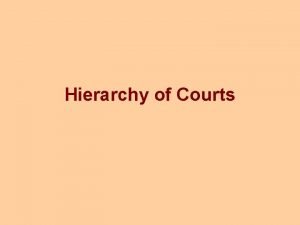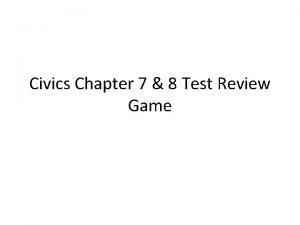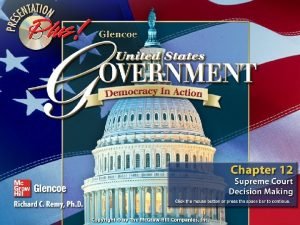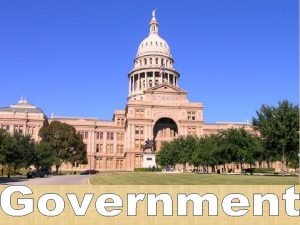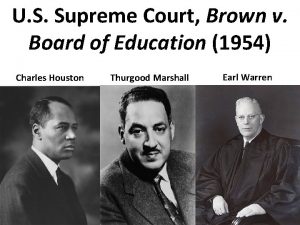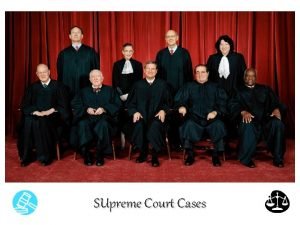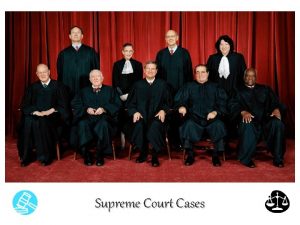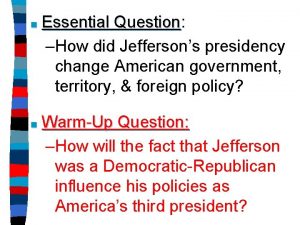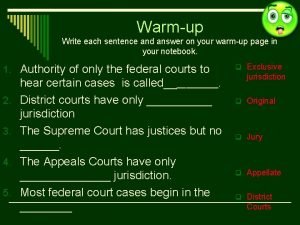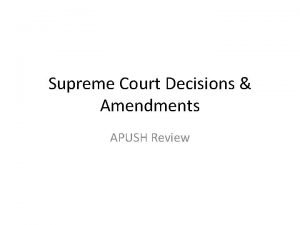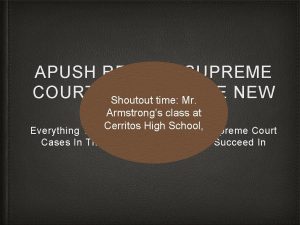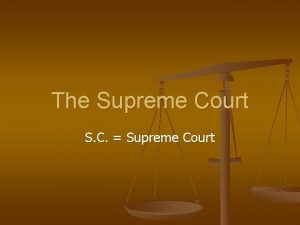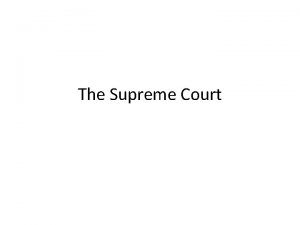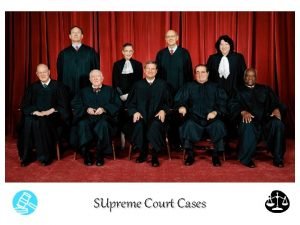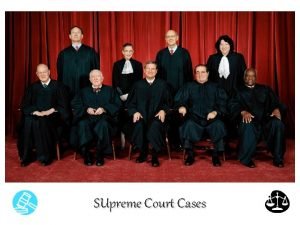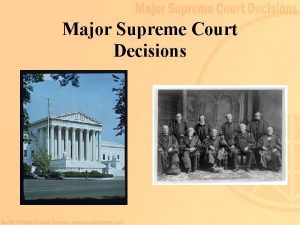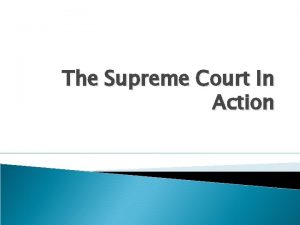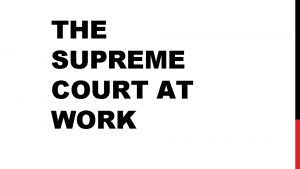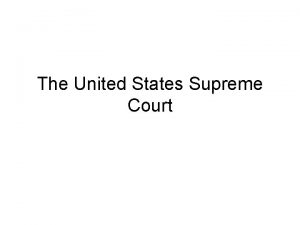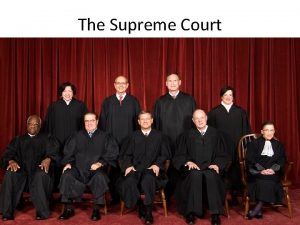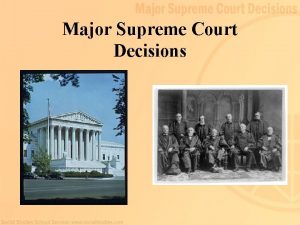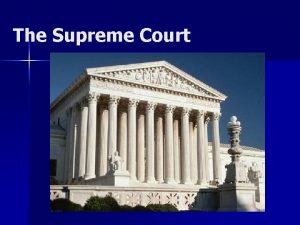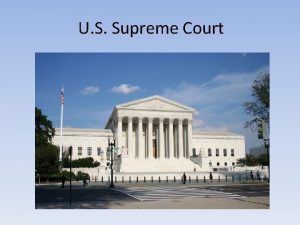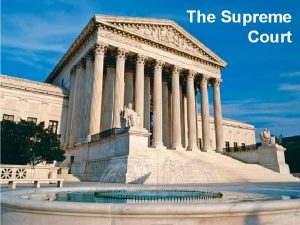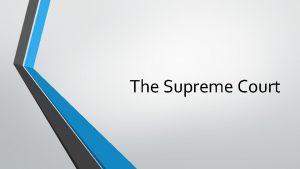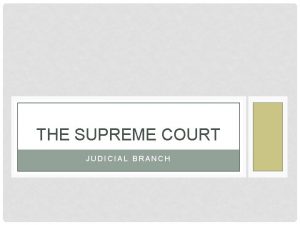The New President and the Supreme Court Artemus




















- Slides: 20

The New President and the Supreme Court Artemus Ward Dept. of Political Science Northern Illinois University aeward@niu. edu http: //www. niu. edu/polisci/a bout/faculty-staff/full-timefaculty/ward-site/ Dupage County Social Studies Conference Wheaton Warrenville South H. S. , Wheaton, IL March 3, 2017

American Political Time • There is a recurring pattern in presidential history, which starts when a transformative presidency creates a new political order out of the ashes of an older one (think the transition from Hoover to FDR). • This transformative president is typically followed by a loyal disciple (Harry Truman, for example), and then by a president of the opposite party who has little choice but to operate within the existing political order (Dwight Eisenhower). • As long as a given political order persists, power rotates between presidents who are devoted to the reigning political orthodoxy (John F. Kennedy and Lyndon Johnson) and those who resist that orthodoxy but can’t quite dislodge it (Richard Nixon). • The cycle ends with a president who seeks to uphold a political order that is on the verge of collapse due to internal conflicts and contradictions that grow ever more difficult to reconcile.

American Political Regimes: Reconstruction • A regime begins with a reconstruction. A president, and other office holders, are elected with expansive warrants to repudiate the politics of those who came before. • These presidents transform the ideological commitments of the nation and fashion a coalition of various interests in order to gain and wield power. • These presidents are generally thought of as the most successful presidents in American history: Jefferson, Jackson, Lincoln, FDR, and Reagan.

American Political Regimes: Articulation • Reconstructive presidents are followed by presidents from the same party who articulate the regime’s commitments. • These are the “heir apparents” and “faithful sons” who apply the orthodoxy of the regime to new issues that arise. • But in doing so, the coalition of interests that held together during the reconstruction begins to fray and these presidents often abdicate or otherwise depart the office under heavy criticism: Monroe, Polk, Theodore Roosevelt, LBJ, and Bush II.

American Political Regimes: Disjunction • Elected toward the end of a political regime, disjunctive presidents are nominally affiliated with the regime (and the reconstructive and articulative presidents who came before them) and preside over the regime’s downfall as the ideological commitments of the regime are called into question and the coalition of interests that held the regime together becomes untenable. • Disjunctive presidents are generally considered among the worst in American history: John Quincy Adams, Pierce, Hoover, and Carter.

American Political Regimes: Preemption • In between the presidencies held by those affiliated with the political regime are presidents from the opposition party who temporarily preempt the regime. • These are the wild cards of American politics with some preemptive presidents able to achieve success (e. g. Cleveland, Eisenhower) by moderating their party’s positions on issues and working with the party that transformed the regime. • However, because they are opposition presidents, they have critics on all sides who attempt to delegitimize them and destroy their presidencies. • Thus, preemptive presidents are often delegitimized and/or impeached: Andrew Johnson, Nixon, Clinton.







Carter’s Disjunction • Carter’s presidency fits the classic politics of disjunction: a president who seeks to uphold a political order that is on the verge of collapse due to internal conflicts and contradictions that grow ever more difficult to reconcile. • The Georgia governor tried to keep together a New Deal coalition that united Northern liberals and Southern conservatives via his idiosyncratic mishmash of Christian moralism, technocratic wonkery, and willingness to reform New Deal policy in a more conservative direction. • He instead triggered intense intra-party opposition, up to and including a formidable primary challenge from Ted Kennedy. • Carter’s “disjunctive” presidency inevitably failed and paved the way for the next transformative presidency: Ronald Reagan’s.

Predictions for the Trump Presidency • Should the patterns of presidential leadership in political time hold true, Trump is the disjunctive president in the decaying New Right political regime that began with Reagan. • Like similarly situated presidents in political time, there were serious questions over whether he was truly a Republican as he campaigned and adopted policy positions that were formerly associated with liberal Democrats (e. g. infrastructure spending, protectionism on trade, health care for all, support for social security and medicare, acceptance of gay rights). • The divisions in the GOP between the moderate (socially liberal, economically conservative) and conservative (socially conservative, economically populist) wings were highlighted during the GOP nomination phase of the 2016 election and continued during Trump’s presidency with Republicans taking sides either for or against Trump on various nominations and policy proposals. • The Democrats will exploit these divisions and ultimately unite behind a new presidential candidate who will repudiate Trump (who will be widely seen as a failed president like the similarly situated presidents before him: Carter, Hoover, Pierce, J. Q. Adams) and most likely reconstruct American politics in a “New Left” political regime.

Predictions for the Trump Presidency • According to literature on American political regimes, the 2016 election of Donald Trump reflects the decaying of the New Right coalition ushered in by Reagan. • The disenchantment that voters feel about the country will continue until a new regime reconstructs the nation’s politics. • What that new regime will look like depends on what the American people broadly want. And there may be a party realignment taking place even now. • If the GOP becomes the party of Trump, moderate Republicans may switch party affiliations and become Democrats. If the Democrats become the party of Sanders/Warren, moderate Democrats may switch their party affiliations and become Republicans.

Further Reading • To learn more about the rise and fall of American political regimes and presidential leadership in political time, see: • Skowronek, Stephen, The Politics Presidents Make: Leadership from John Adams to Bill Clinton, revised ed. (New York: Belknap Press, 1997). • Skowronek, Stephen, Presidential Leadership in Political Time: Reprise and Reappraisal, 2 nd ed. (Lawrence: University Press of Kansas, 2011). • For a brief history of each American presidential election, see: • Boller, Paul F. Jr. , Presidential Campaigns: From George Washington to George W. Bush (New York: Oxford University Press, 2004).



Judge Neil Gorsuch: Extreme Conservative • According to new research by political scientists, Judge Gorsuch would be the most conservative justice on the Supreme Court. • Comparing Gorsuch’s votes as a court of appeals judge (2007 -2016) on cases that the Supreme Court subsequently decided (26 cases), we can see that he voted more consistently for the conservative position than any of the justices ultimately did—including Clarence Thomas. • Gorsuch’s behavior (2. 94) was significantly more conservative than his predecessor, Antonin Scalia (1. 22). • Gorsuch was also more conservative than both Alito (0. 97) and Thomas (1. 79), thereby making him the most conservative justice by far.

Future Retirements? • Liberals: • Ruth Bader Ginsburg – Born: March 15, 1933 (age 83) • Stephen Breyer – Born: August 15, 1938 (age 78) • Conservatives: • Anthony Kennedy – Born: July 23, 1936 (age 79) • Average at death for Supreme Court Justices: 90 • Justice John Paul Stevens recently retired at age 90. He is now age 96. • What are the chances that any of these justices will retire in the next few years? • On Feb. 23, 2017, Sen. Ted Cruz (R-TX), a former Supreme Court law clerk, said that he expected a retirement “if not this summer, next summer. ” The next day, Ginsburg said: “I will do this job as long as I can do it full steam. When I can't, that will be the time I will step down. ” Noting that Stevens departed at 90, she added: “So I have a way to go. ”
 Is there a basketball court above the supreme court
Is there a basketball court above the supreme court What do these headlines say about how the supreme court
What do these headlines say about how the supreme court Vocabulary activity 12 supreme court decision making
Vocabulary activity 12 supreme court decision making Supreme court justice system
Supreme court justice system The supreme court change
The supreme court change Jurisdiction of high court
Jurisdiction of high court The u.s. supreme court works chiefly as a(n)
The u.s. supreme court works chiefly as a(n) Supreme court does
Supreme court does Supreme court does
Supreme court does Have supreme court
Have supreme court Indictable offence
Indictable offence Supreme court
Supreme court Supreme court
Supreme court Supreme court cases graphic organizer answers
Supreme court cases graphic organizer answers Supreme court cases graphic organizer answers
Supreme court cases graphic organizer answers Which of these best summarizes the monroe doctrine?
Which of these best summarizes the monroe doctrine? John marshall supreme court
John marshall supreme court John marshall supreme court
John marshall supreme court How cases reach the supreme court worksheet answers
How cases reach the supreme court worksheet answers Apush supreme court cases
Apush supreme court cases Schechter poultry v us apush
Schechter poultry v us apush


